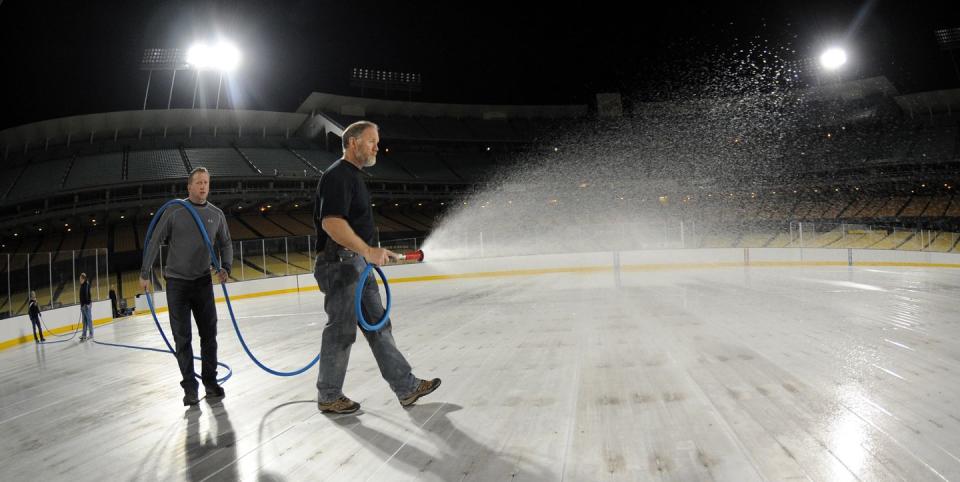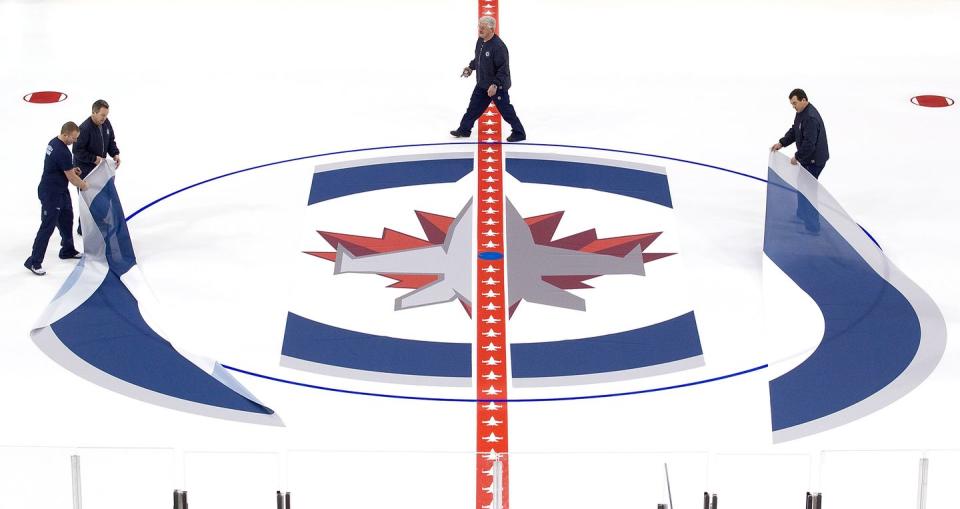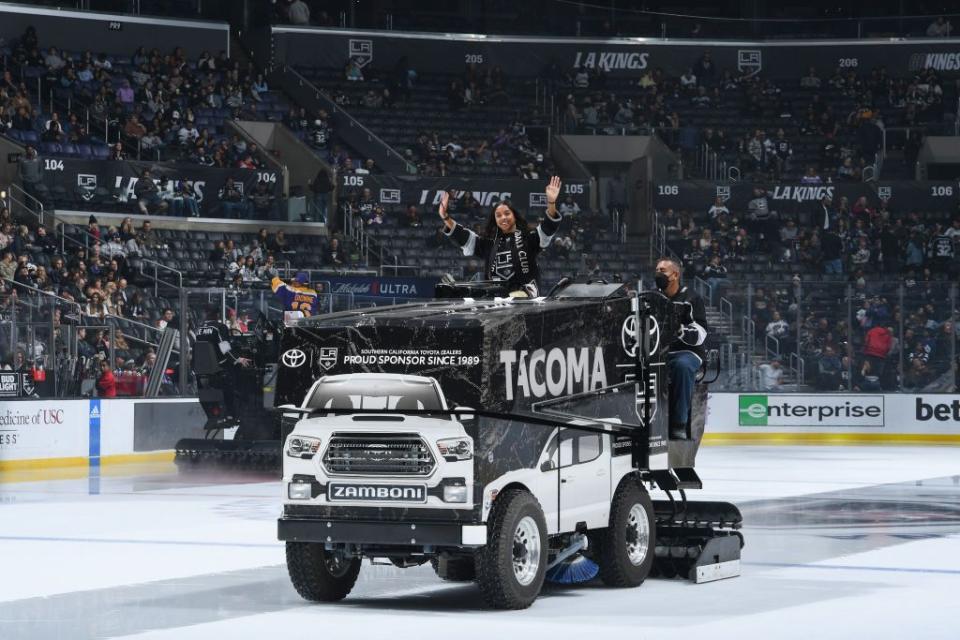Behind the Scenes on How the NHL Makes and Maintains Such Perfect Ice

A refrigeration system in the concrete floors of arenas keep NHL ice frozen throughout the season.
Some arenas paint logos while others use a textile fabric sandwiched in ice layers.
Water purification systems standardize the quality of ice across North American arenas.
It takes days to build a sheet of National Hockey League (NHL) ice—and an entire season to watch it perform.
🏒 You want to know how your world works. So do we. Let’s find out together—join Pop Mech Pro.
The 200-foot by 85-foot sheet of ice created for the start of an NHL season each autumn will typically last the duration of the season, thanks to the careful build process and the exacting refrigeration engineering designed to keep the ice fresh. No matter the weather outside or the event inside, such as National Basketball Association (NBA) games or arena-filling concerts, the frozen layer remains unbroken.
Across the 32 NHL arenas, the process of ice-making is the same and is governed by league-set specifications to help keep the ice uniform from one venue to the next. Before thinking about freezing it though, folks like Mike Craig, NHL senior manager of facility operations, have to think about the quirks of their local arena’s water supply. (His father, Dan Craig, who oversaw the construction of NHL outdoor rinks for 24 years before retiring in 2021, is pictured above.) That’s because every part of the U.S.—northern, southern, coastal, or central areas—has a different water mineral composition. And water is gathered from a variety of sources, affecting the behavior and quality of the ice sheet you end up with. For example, Seattle, Washington’s Climate Pledge Arena uses reclaimed rainwater for its rink.
“That’s why we have water purification and reverse osmosis systems, depending on the domestic water coming out of the tap, so our end product is very consistent around the league,” Craig tells Popular Mechanics.
Those water quality requirements regulate the hardness of the water, what minerals can and can’t be found in the water, and the total dissolved solids content. All water properties must fall within a certain range to make consistent ice nationwide. After the tap water is processed to the NHL standard, the ice sheet build can begin.
How to Freeze Over Ten Thousand Gallons of Water

“As buildings get ready for the beginning of the season, one of the big steps is the initial ice install,” Craig says. “That ice gets installed, and typically that is the ice that will be in all year long.”
Aside from the water itself, the key ingredient for making an ice-filled arena is a refrigeration system, engineered to operate within the concrete floor. It uses piping that’s filled with either a frosty glycol or a brine solution, which helps freeze the water hitting the floor. It also maintains the right temperature throughout the season.
To lay down the ice, the refrigeration system first adjusts to between 16 and 18 degrees Fahrenheit. A “bonding layer” of five to six cold sprays of water sets the base. Then come three coats of water-soluble white paint, to give the ice its base look, followed by another five to six cold-water sealing sprays.
From there, crews carefully detail the game’s required lines and rink markings. These are painted onto the ice; logos are installed in the same layer. Some teams still paint logos, but most have turned to a textile fabric, Craig says. “From there, we seal all that in,” he says. “At that point, the ice is still very, very thin.”

To get to the finished thickness of 1 to 1.5 inches, crews then apply 100 gallons of water at a time over the course of a few days, adding another 10,000 to 15,000 gallons distributed among multiple sprays for a “very dense, high-quality sheet of ice,” Craig explains. This is the final building step.
...And How to Maintain a Pristine Frozen Layer
With the ice installed, the 24/7 remote monitoring of the refrigeration system focuses on keeping the top layer of the playing surface a steady 22 to 23 degrees Fahrenheit.
That effort takes work, whether due to fluctuating temperatures and humidity outside or changing environments indoors. Craig says at least 30 different things can affect the quality of the ice, so teams are constantly monitoring and tweaking mechanical systems throughout the building and under the ice.
Extra care is required when events other than ice hockey or ice skating take over the frozen arenas. Some of the world’s busiest arenas, such as Madison Square Garden in New York City, or Crypto.com Arena in Los Angeles, can host a different event every night of the week. Though it goes undercover, the ice is still there throughout the hockey season, hidden beneath an ice cover. In fact, there’s only one layer between the ice and the event above it.
Following each game, the ice is resurfaced, and a fiber-reinforced polyurethane cover goes on. That lid protects the ice on one side and serves as a true floor on the other, with the NBA hardwood or concert setup sitting directly on top.
Because the ice gets covered and the temporary floor doesn’t allow heat to pass through it, Craig says they can adjust the setting on the concrete refrigeration system to raise the temperature a bit. Once the NBA game or concert concludes, crews simply pull up the floor and touch up the ice with a resurfacing treatment before the next NHL game.
With the focus always on the top layer of the ice, keeping it pristine takes more than the concrete refrigeration system. Outside temperature and humidity force an arena’s mechanical heating, ventilation, and air conditioning systems to work harder to keep the building at optimal conditions during an NHL game: between 60 and 64 degrees Fahrenheit with 40 percent to 45 percent humidity.
Getting there can be tricky, especially knowing that when the doors open and generally over 15,000 fans flood through, it can increase the indoor temperature by at least a couple of degrees. “We work throughout the day to get ahead of that bump and start cooler and drier,” Craig says.

The ice itself is refreshed during the game. Two intermissions give the ice crew no more than 14 minutes per intermission to resurface the ice prior to the next period starting. Using two ice resurfacing machines per arena, it takes about five minutes to resurface the ice. Twenty-seven of the arenas employ Zamboni machines, and the rest use Olympia brand machines.
“We try to put as much water as we can out there, anywhere around 100 gallons of water for each resurface,” Craig says. “Depending on the conditions, the operators will adjust how they resurface.” It takes an additional five to six minutes for the fresh water to freeze, requiring everything within that intermission to be timed down to the minute.
Each resurfacing requires an end product that is “perfectly frozen,” Craig says. Paying proper care to that top layer means NHL ice gets installed once, and it’s game-ready for an entire season.
You Might Also Like
